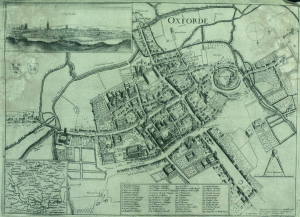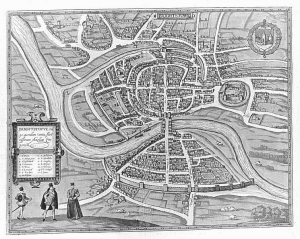Up to now we’ve mostly been working inside the city walls, where space is short and buildings necessarily packed
closely together. We’re now going to turn to the area outside the walls. In this installment, we’re going to turn back to some theory.
First we need to talk about why businesses decide to set up outside the walls of the city. After all, they are forgoing the protection that walls bring, so there must be some good reasons for it. It turns out the reasons are pretty simple:
- Avoiding authority: This is monetary, avoiding taxes, but also includes regulation, attention of the town watch, even to avoiding the prying eyes of neighbors. The city’s authority ends with the city walls, and some people find their business flourishes where there is less oversight.
- Accessing markets: Gates into the city are notorious choke points for people entering the city. The gates typically only open at certain times, guards ask questions, and just the physical size of the gate all conspire to leave large numbers of people waiting outside to get in. And where there are large numbers of people waiting or stranded, there is money to be made selling goods and services to them.
- Space: In many cities, space is at a premium. So businesses that require lots of space such as cattle markets, or that need space from neighbors, such as tanners, will often set up outside the city walls.
What this leads to is a mini city just outside the city walls, where crowds are most likely to form. This is where taverns and inns, and potentially more reputable shops can be found as well.
As you move away from the gate, more space opens up and larger markets and establishments have more room. Typically these spread out along the main roads leading away from the gate. Over time, some side roads may form if the population of the city continues to grow.
You might guess that citizens of the city are unlikely to approve of markets being established outside their walls. They will object to being undercut on price, object to the less savory businesses that occur outside the walls, and complain about customers journeying to their city experiencing the underside of the city before coming through the gates.
Over time, as the city outside the gates grows, the city will expand its limits to incorporate land outside the walls. Then the pressure will grow to expand the walls to encompass the new land. Once funds can be raised to build the wall, the city will expand and cannibalize the old walls.
The City Mapping Series
Part 1: Location, Location, Location
Part 2: Urban Planning
Part 3: Laying out Districts
Part 4: Districts in CC3
Part 5: Sizing Buildings
Part 6: Filling Blocks in CC3
Part 7: Houses Galore!
Part 8: Outside the Gates


Wonderful article! More of this, more theory – it gives new insights and lot of ideas. Many thanks!